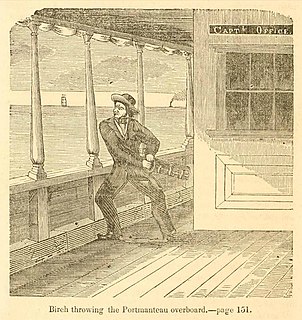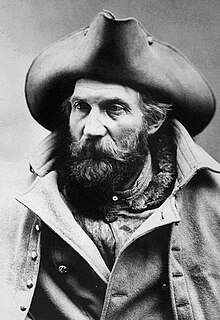 W
WRobert H. "Three-Fingered" Birch, born Robert Henry Birch, was a 19th-century American adventurer, criminal, soldier, lawman, postmaster, and prospector. He was a member of the infamous "Banditti of the Prairie" in his youth, whose involvement in the torture-murder of Colonel George Davenport in 1845 led to his turning state's evidence against his co-conspirators. Birch was also the discoverer of the Pinos Altos gold mine with Jacob Snively and James W. Hicks. During the American Civil War, he served in the American Southwest with the Confederate forces of the Arizona Rangers and 2nd Texas Cavalry.
Nicholas C. Creede was an American prospector famous for discovering the Holy Moses Amethyst vein and other mining properties near Creede, Colorado in the late 1880s and early 1890s.
 W
WJames Graham Fair was an Irish immigrant to the United States who became a highly successful mining engineer and businessman. His investments in silver mines in Nevada made him a millionaire, and he was one of the famous "silver kings" who became wealthy on the Comstock Lode. Fair later became a real estate investor and railroad builder in California. In 1881, he was elected a United States Senator from Nevada.
 W
WColonel William Cornell Greene was an American businessman who was famous for discovering rich copper reserves in Cananea, Mexico, and for founding the Greene Consolidated Copper Company in 1899. By 1905, Greene was one of the wealthiest businessmen in the world.
 W
WGeorge Hearst was an American businessman, miner, and politician. After growing up on a small farm in Missouri, he founded many mining operations, and is known for developing and expanding the Homestake Mine in the late 1870s in the Black Hills of South Dakota. In 1879 he listed it on the New York Stock Exchange, and went on to other pursuits. The mine operated continuously, producing gold until 2001.
 W
WSeth Kinman was an early settler of Humboldt County, California, a hunter based in Fort Humboldt, a famous chair maker, and a nationally recognized entertainer. He stood over 6 ft (1.83 m) tall and was known for his hunting prowess and his brutality toward bears and Indian warriors. Kinman claimed to have shot a total of over 800 grizzly bears, and, in a single month, over 50 elk. He was also a hotel keeper, saloon keeper, and a musician who performed for President Lincoln on a fiddle made from the skull of a mule.
 W
WJesse Knight was an American mining magnate, one of relatively few Latter-day Saint in nineteenth century Western America to find major success in the field.
 W
WJohn William Mackay was an Irish-American industrialist. Mackay was one of the four Bonanza Kings, a partnership which capitalised on the wealth generated by the silver mines at the Comstock Lode.
 W
WJohn J. Manning was an Irish American frontiersman, lawman, gold prospector, rancher and saloon owner in the American West during the latter part of the 19th century. He was a prominent citizen in Deadwood, South Dakota from his arrival in 1876 to his death. Manning was the first elected sheriff of Lawrence County, Dakota Territory which included Deadwood. He served several terms as sheriff, as well as operated saloons, several livery stables, and a cattle & horse ranch in nearby Belle Fourche in South Dakota.
 W
WBrushy Bill Roberts also known as William Henry Roberts, Ollie Partridge William Roberts, Ollie N. Roberts or Ollie L. Roberts, attracted attention by claiming to be the western outlaw William H. Bonney, also known as Billy the Kid. Roberts' claim was rejected by Governor Thomas Mabry in 1950. Brushy Bill's story is promoted by the "Billy the Kid Museum" in his hometown of Hico in Hamilton County, Texas. His claim was explored in a 2011 episode of Brad Meltzer's Decoded and a segment by Robert Stack in 1989 on Unsolved Mysteries.
 W
WEdward Lawrence Schieffelin (1847–1897) was an Indian scout and prospector who discovered silver in the Arizona Territory, which led to the founding of Tombstone, Arizona. He partnered with his brother Al and mining engineer Richard Gird in a handshake deal that produced millions of dollars in wealth for all three men. During the course of Tombstone's mining history, about US $85,000,000 in silver was produced from its mines.
 W
WWinfield Scott Stratton was an American prospector, capitalist, and philanthropist. He discovered the Independence Lode near Victor, Colorado on July 4, 1891, and became the Cripple Creek Mining District's first millionaire in 1894. He provided to build buildings, improve the street car system, build the first professional ball park, and provided funds to people in need.
 W
WHorace Austin Warner ("Haw") Tabor, also known as The Bonanza King of Leadville, was an American prospector, businessman, and Republican politician. His life is the subject of Douglas Moore's opera, The Ballad of Baby Doe; and the 1932 Hollywood biographical movie: Silver Dollar. Also, Graham Masterton's 1987 novel Silver has a protagonist named Henry T. Roberts, whose life includes incidents from Tabor's.
 W
WCharles H. "Colorado Charlie" Utter was a figure of the American Wild West, best known as a great friend and companion of Wild Bill Hickok. He was also friends with Calamity Jane.
 W
WJoseph R. Walker was a mountain man and experienced scout. He established the segment of the California Trail, the primary route for the emigrants to the gold fields during the California gold rush, from Fort Hall, Idaho to the Truckee River. The Walker River and Walker Lake in Nevada were named for him by John C. Frémont.
 W
WGeorge Warren worked as a prospector in the Tombstone and Bisbee, Arizona region during the late 19th century. He is credited with having located the body of copper ore, which later was known as the Copper Queen Mine, one of Arizona's most productive copper mines. Warren drank too much and bet his interest in the mine on a foot race against a horse and lost.
 W
WPauline Weaver, born Powell Weaver, was an American mountain man, trapper, military scout, prospector, and explorer who was active in the early Southwestern United States. A number of geographic features in Arizona are named after him.
 W
WHenry S. Yount was an American Civil War soldier, mountain man, professional hunter and trapper, prospector, wilderness guide and packer, seasonal employee of the United States Department of the Interior, and the first game warden in Yellowstone National Park. He was nicknamed "Rocky Mountain Harry Yount".